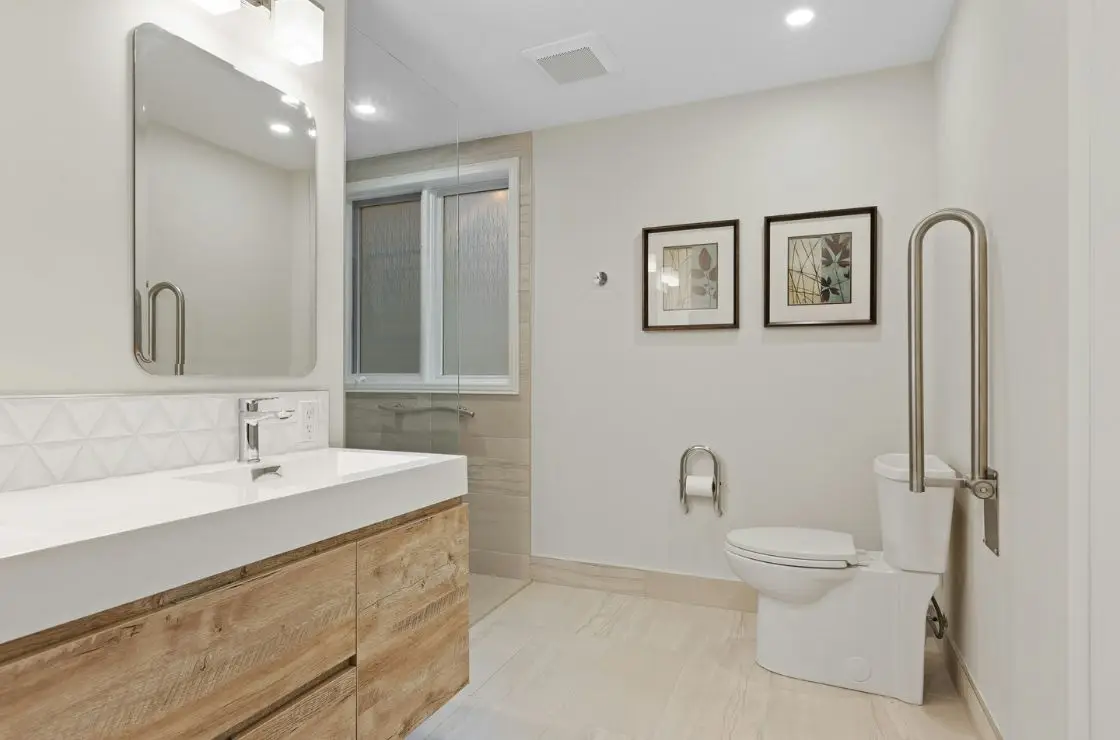About 39 million Americans struggle with motor impairments (otherwise known as physical disabilities or limitations). These may be temporary, like navigating the world with a broken limb, age-related, or permanent. Regardless of why someone has a motor impairment, they need a more accessible space. Do you have someone in your life who could benefit from a more accessible home?
Bathrooms are often inaccessible, especially in older homes. This can create unsafe conditions, like slippery showers. Luckily, there are many fantastic accessibility options available for anyone who’s willing and ready to remodel their space.
Read on for our top tips for an accessible and safe bathroom remodel.
Choose Safe Flooring
The flooring in your bathroom is crucial for safety. Slippery floors can lead to falls and injuries, so it’s important to choose a slip-resistant material such as textured tiles, rubber flooring, or even textured vinyl. Often, this flooring looks just like “normal” flooring, but with an added safety twist. Modern flooring has come a long way when it comes to safety and accessibility.
If you don’t like the look of any “safe” flooring that’s available, invest in good non-slip mats. These will add extra grip and texture to the floors and make them safer.
Install Grab Bars
Grab bars are essential for providing support and balance in the bathroom. Many people don’t realize how helpful (and in some cases, essential) they can be until they experience a fall. Get ahead of the problem by installing them now.
Install your grab bars in strategic locations such as near the toilet, inside the shower, and even by the sink. Focus on areas that require sitting or bending, as well as anywhere that may be prone to getting wet (which is a lot of places within the bathroom). It’s always better to be safe rather than sorry, so if you’re not totally sure that you need a grab bar, it’s best to install it as a precaution.
Upgrade the Shower and Bathtub
It can be harder to get in and out of the shower or bathtub as people age or if they otherwise struggle with their mobility. If you’re remodeling your bathroom anyway, it’s a great opportunity for a quick shower upgrade.
Consider installing a walk-in shower or a bathtub with a door to make it easier to get in and out. This will reduce the chance of slipping and make it easier for people who may struggle to stand on one foot even for a moment.
There are also other things you can add to improve the shower area. A shower chair or bench is an easy addition, as is a handheld showerhead to make bathing far easier and safer.
Adjust the Toilet Area
Too many people don’t consider the need for an accessible toilet, even in an otherwise accessible home. Remember that if someone struggles to sit down and stand up, a standard toilet can be problematic for them.
Install a toilet seat riser or elevator to make it easier to use. You can also add grab bars nearby and a toilet seat with a built-in bidet for an easier and more comfortable experience.
Create a Comfortable Sink and Vanity Area
A more comfortable and accessible sink and vanity area is more functional for everyone in the home. There will generally be more space for storage and the height will be more comfortable for the majority of people.
Choose a sink that is at a comfortable height, that has lever handles instead of knobs, and that has a single-handle faucet. Make sure the countertop is easy to wipe down and that there’s plenty of space to place objects.
Make Accessible Lighting Adjustments
Proper lighting is essential for safety in the bathroom. Dim mood lighting might look nice, but it’s not a part of accessible design.
Install bright overhead lighting for the main bathroom lights. On top of that, it’s a good idea to install specific task lighting around or above the sink and shower. These lights can be dimmer. They add extra light for accessibility purposes, but they’re also helpful at night when you don’t want to use the bright overhead lights.
Motion-sensing night lights are also a good idea.
Create Easily Accessible Storage
It feels like bathrooms never have enough storage! Often, the best storage is high-up, making it inaccessible for anyone who’s below average height or who has mobility struggles. This can lead to a lot of clutter, which can get dangerous (and just inconvenient).
Keep the bathroom clutter-free by installing cabinets with easy-to-grasp handles that are at a comfortable height. Anything too high or too low may not work. Within the cabinets, or even on the walls, place shelves at a comfortable height as well. Instead of just a mirror, consider a mirrored medicine cabinet for extra storage.
Utilize Universal Design
Universal design is the design of a space to make it as understandable and accessible as possible to the widest range of people. If you have the ability to make large changes during your remodeling project, use universal design principles.
Consider universal design principles such as wide doorways to make space for mobility devices, a curbless shower for easy entry and to lower the chance of falls, and potentially a wall-mounted sink for greater space in the bathroom, as long as the vanity counter space isn’t essential.
Get Professional Help With Your Accessible Bathroom Remodel
Everyone deserves a safe and accessible space to call home, and that extends to the restroom. If you’re unsure about how to create a safe and accessible bathroom, consider hiring a professional who can help you brainstorm ideas that will work best for you and the other people within your home. An accessible bathroom is a safe bathroom.
At LA Carpets, we don’t only install fantastic flooring. We’re also local experts in bathroom and kitchen remodeling, and we’re ready to help you upgrade your space. Reach out to get your free estimate today so we can get started.


